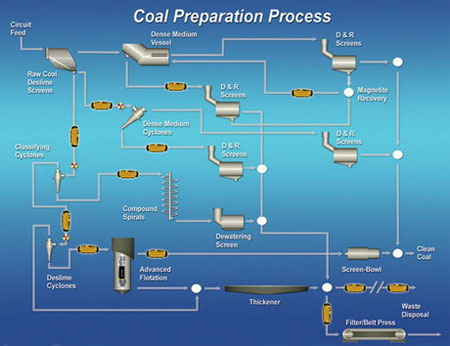Instrumentation in the coal preparation plant is relatively simple in comparison with instrumentation at other process industries. The instruments generally found on coal preparation equipment are described below.
Conveyor
The conveyors are driven by electric motors; the current drawn by the conveyor motors varies directly with the conveyor load. The ammeters located in the control room indicate the instantaneous current drawn by the conveyor motors. When excessive current is indicated, conveyor and equipment loading should be investigated.
Some conveyors are also equipped with load meters. These meters indicate the percent of rated load carried by the conveyor at a particular instant. Ammeters and load meters give basically similar indications.
Crushers
The crusher load is directly proportional to the feed rate and feed sizes. The crusher is driven by an electric motor. The ammeter for the motor is generally located in the central control room. Indication of excessive current should be investigated to determine the cause.
Screens
In addition to the load-current ammeters, the screens may be equipped with pressure gauges indicating the pressure of water to the sprays. The various correct combinations of load current and spray pressure should be established during performance tests for reference during periodic inspections. The increase in load current would mean increased screen loading; this should be matched by increased spray water, which will be indicated by the pressure gauge.
Air Tables
In general, the new air table installations will be equipped with instruments to indicate the load current, pressure drop across the air table, and pressure drop across the control equipment. The load current is indicated by the ammeter; pressure drops are indicated by the pressure gauges. These instruments can be located in a central control room. The correct combinations of these parameters should be established during performance tests for future reference.
An excessive pressure drop across the air table means a higher percentage of fine coal in the table feed. This will also result in an increased load on the control device. The pressure drop across the control device should be matched to meet the increased particulate loading.
Thermal Dryers
Thermal dryers are equipped with instruments to indicate the feed rate and exit gas temperature. The exit gas temperature is continuously recorded and monitored. In the case of thermal dryers with venturi scrubbers, scrubber water supply pressure and pressure loss in the venturi constriction are also continuously monitored. The monitoring aspects are discussed under records.
The thermal dryer feed rate indicates the quantitative loading; however, this may not be useful for predicting the emissions. Emissions from the thermal dryer would depend on the moisture and fine-coal percentage of the feed.
Records
The NSPS require the continuous monitoring of the flue gas temperature at the exit of the thermal dryer, pressure of the water supply to the venturi scrubber, and pressure loss in the venturi constriction. A record of these parameters must be available at the plant for inspection.
Other records, though not required under the NSPS, showing the plant feed rates and equipment malfunction and shutdown should be inspected to determine the plant’s emissions between inspections.


